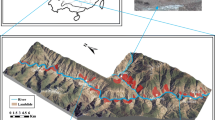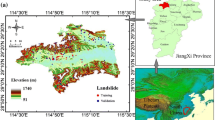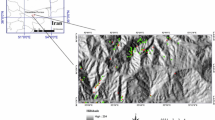Abstract
The utilization of different connection methods between landslides and environmental factors introduces uncertainty in landslide susceptibility prediction (LSP). Investigating and identifying the characteristics of this uncertainty and determining more suitable connection methods are of significant importance for LSP. This study uses original 12 environmental factors data as well as calculated data from five connection methods, namely, probability statistics (PS), frequency ratio (FR), information volume (IV), index of entropy (IOE), and weight of evidence (WOE), as model input variables. Then, four machine learnings logistic regression (LR), Bayesian networks (BN), support vector machines (SVM) and C5.0 Decision Trees (C5.0 DT) are combined with the calculated data and the original data to create 24 unique combinations of connection methods and models. Under these 24 combinations, the uncertainty analysis of LSP modeling is conducted, using Huichang County of China as an example. The analysis entails accuracy assessment, statistical analysis of landslide susceptibility indexes (LSIs), distribution patterns of LSIs and sensitivity analysis of the two uncertainty issues. The results show that: 1) LSP accuracies of the FR-, IV- and IOE-based models are comparable, but are lower than those of the WOE-based models, with those of the PS-based models being the worst. WOE has better nonlinear connection performance than the other methods. 2) LSP accuracies of individual models are slightly lower than those of coupled models, but their modeling efficiencies are higher than those of coupled models. 3) The machine learning is more sensitive than the connection method for LSP. In short, WOE-C5.0 DT has the lowest LSP uncertainty while a single machine learning can produce satisfied LSP results with high modelling efficiency.
Similar content being viewed by others
Abbreviations
- LSP:
-
Landslide susceptibility prediction
- LSIs:
-
Landslide susceptibility indexes
- LR:
-
Logistic regression
- BN:
-
Bayesian networks
- SVM:
-
Support vector machines
- C5.0 DT:
-
C5.0 Decision Trees
- PS:
-
Probability statistics
- IV:
-
Information volume
- IOE:
-
Index of entropy
- WOE:
-
Weight of evidence
- FR:
-
Frequency ratio
- AUC:
-
Area under receiver operation characteristic curve
References
Abedi GH, Feizizadeh B (2021) GIS-based ensemble modelling of fuzzy system and bivariate statistics as a tool to improve the accuracy of landslide susceptibility mapping. Natural Hazards 107(2):1981–2014, DOI: https://doi.org/10.1007/s11069-021-04673-1
Achour Y, Pourghasemi HR (2020) How do machine learning techniques help in increasing accuracy of landslide susceptibility maps? Geoscience Frontiers 11(3):871–883, DOI: https://doi.org/10.1016/j.gsf.2019.10.001
Adnan MSG, Rahman MS, Ahmed N, Ahmed B, Rabbi MF, Rahman RM (2020) Improving spatial agreement in machine learning-based landslide susceptibility mapping. Remote Sensing 12(20):3347, DOI: https://doi.org/10.3390/rs12203347
Aghdam IN, Pradhan B, Panahi M (2017) Landslide susceptibility assessment using a novel hybrid model of statistical bivariate methods (FR and WOE) and adaptive neuro-fuzzy inference system (ANFIS) at southern Zagros Mountains in Iran. Environmental Earth Sciences 76(6):237, DOI: https://doi.org/10.1007/s12665-017-6558-0
Akinci H, Yavuz Ozalp A (2021) Landslide susceptibility mapping and hazard assessment in Artvin (Turkey) using frequency ratio and modified information value model. Acta Geophysica 69(3):725–745, DOI: https://doi.org/10.1007/s11600-021-00577-7
Al-Najjar HAH, Pradhan B (2021) Spatial landslide susceptibility assessment using machine learning techniques assisted by additional data created with generative adversarial networks. Geoscience Frontiers 12(2):625–637, DOI: https://doi.org/10.1016/j.gsf.2020.09.002
Arabameri A, Pradhan B, Rezaei K, Lee CW (2019) Assessment of landslide susceptibility using statistical- and artificial intelligence-based FR–RF integrated model and multiresolution DEMs. Remote Sensing 11(9):999, DOI: https://doi.org/10.3390/rs11090999
Batar AK, Watanabe T (2021) Landslide susceptibility mapping and assessment using geospatial platforms and weights of evidence (WoE) method in the indian himalayan region: Recent developments, Gaps, and future directions. ISPRS International Journal of Geo-Information 10(3):114, DOI: https://doi.org/10.3390/ijgi10030114
Chang Z, Du Z, Zhang F, Huang F, Chen J, Li W, Guo Z (2020) Landslide susceptibility prediction based on remote sensing images and GIS: Comparisons of supervised and unsupervised machine learning models. Remote Sensing 12(3):502, DOI: https://doi.org/10.3390/rs12030502
Chang Z, Huang J, Huang F, Bhuyan K, Meena SR, Catani F (2023a) Uncertainty analysis of non-landslide sample selection in landslide susceptibility prediction using slope unit-based machine learning models. Gondwana Research 14(5):101619, DOI: https://doi.org/10.1016/j.gr.2023.02.007
Chen W, Zhang S (2021) GIS-based comparative study of Bayes network, Hoeffding tree and logistic model tree for landslide susceptibility modeling. Catena 203:105344
Chang Z, Huang F, Huang J, Jiang S-H, Liu Y, Meena SR, Catani F (2023b) An updating of landslide susceptibility prediction from the perspective of space and time. Geoscience Frontiers 14(5):101619, DOI: https://doi.org/10.1016/j.gsf.2023.101619
Demir G (2019) GIS-based landslide susceptibility mapping for a part of the North Anatolian Fault Zone between Reşadiye and Koyulhisar (Turkey). Catena 183:104211, DOI: https://doi.org/10.1016/j.catena.2019.104211
Di Napoli M, Carotenuto F, Cevasco A, Confuorto P, Di Martire D, Firpo M, Pepe G, Raso E, Calcaterra D (2020) Machine learning ensemble modelling as a tool to improve landslide susceptibility mapping reliability. Landslides 17(8):1897–1914, DOI: https://doi.org/10.1007/s10346-020-01392-9
Duan G, Zhang J, Zhang S (2020) Assessment of landslide susceptibility based on multiresolution image segmentation and geological factor ratings. International Journal of Environmental Research and Public Health 17(21):7863, DOI: https://doi.org/10.3390/ijerph17217863
Guo J, Xu M, Zhang Q, Xiao X, Zhang S, He S (2020) Reservoir regulation for control of an ancient landslide reactivated by water level fluctuations in heishui river, China. Journal of Earth Science 31:1058–1067, DOI: https://doi.org/10.1007/s12583-020-1341-7
Hong H, Chen W, Xu C, Youssef AM, Pradhan B, Tien Bui D (2017) Rainfall-induced landslide susceptibility assessment at the Chongren area (China) using frequency ratio, certainty factor, and index of entropy. Geocarto International 32(2):139–154, DOI: https://doi.org/10.1080/10106049.2015.1130086
Hong H, Shahabi H, Shirzadi A, Chen W, Chapi K, Ahmad BB, Roodposhti MS, Yari Hesar A, Tian Y, Tien Bui D (2018) Landslide susceptibility assessment at the Wuning area, China: A comparison between multi-criteria decision making, bivariate statistical and machine learning methods. Natural Hazards 96:173–212, DOI: https://doi.org/10.1007/s11069-018-3536-0
Hu X, Mei H, Zhang H, Li Y, Li M (2020) Performance evaluation of ensemble learning techniques for landslide susceptibility mapping at the Jinping county, Southwest China. Natural Hazards 105:1663–1689, DOI: https://doi.org/10.1007/s11069-020-04371-4
Huang F, Cao Z, Jiang S-H, Zhou C, Huang J, Guo Z (2020) Landslide susceptibility prediction based on a semi-supervised multiple-layer perceptron model. Landslides 17:2919–2930, DOI: https://doi.org/10.1007/s10346-020-01473-9
Huang F, Pan L, Fan X, Jiang S-H, Huang J, Zhou C (2022) The uncertainty of landslide susceptibility prediction modeling: Suitability of linear conditioning factors. Bulletin of Engineering Geology the Environment 81(5):182, DOI: https://doi.org/10.1007/s10064-022-02672-5
Huang F, Xiong H, Yao C, Catani F, Zhou C, Huang J (2023) Uncertainties of landslide susceptibility prediction considering different landslide types. Journal of Rock Mechanics and Geotechnical Engineering, DOI: https://doi.org/10.1016/j.jrmge.2023.03.001
Jiang J, Zhang Z, Wang D, Wang L, Han X (2022) Web pillar stability in open-pit highwall mining. International Journal of Coal Science Technology 9(1):12, DOI: https://doi.org/10.1007/s40789-022-00483-3
Kadirhodjaev A, Kadavi PR, Lee C-W, Lee S (2018) Analysis of the relationships between topographic factors and landslide occurrence and their application to landslide susceptibility mapping: A case study of Mingchukur, Uzbekistan. Geosciences Journal 22:1053–1067, DOI: https://doi.org/10.1007/s12303-018-0052-x
Khanna K, Martha TR, Roy P, Kumar KV (2021) Effect of time and space partitioning strategies of samples on regional landslide susceptibility modelling. Landslides 18:2281–2294, DOI: https://doi.org/10.1007/s10346-021-01627-3
Li W, Fan X, Huang F, Chen W, Hong H, Huang J, Guo Z (2020) Uncertainties analysis of collapse susceptibility prediction based on remote sensing and GIS: Influences of different data-based models and connections between collapses and environmental factors. Remote Sensing 12(24):4134, DOI: https://doi.org/10.3390/rs12244134
Li Q, Huang D, Pei S, Qiao J, Wang M (2021) Using physical model experiments for hazards assessment of rainfall-induced debris landslides. Journal of Earth Science 32:1113–1128, DOI: https://doi.org/10.1007/s12583-020-1398-3
Li G, Yang X, Wang D, Wang Y, Yu X (2022) Stability of inner dump slope under coal pillar support: Case study in an open-pit coal mine. International Journal of Coal Science & Technology 9(1):25, DOI: https://doi.org/10.1007/s40789-022-00493-1
Li R, Wang N (2019) Landslide susceptibility map** for the Muchuan county (China): A comparison between bivariate statistical models (woe, ebf, and ioe) and their ensembles with logistic regression. Symmetry 11(6):762
Liu LL, Zhang J, Li JZ, Huang F, Wang LC (2022) A bibliometric analysis of the landslide susceptibility research (1999-2021). Geocarto International 37(26):14309–14334, DOI: https://doi.org/10.1080/10106049.2022.2087753
Ma J, Tang H, Liu X, Hu X, Sun M, Song Y (2017) Establishment of a deformation forecasting model for a step-like landslide based on decision tree C5.0 and two-step cluster algorithms: A case study in the Three Gorges Reservoir area, China. Landslides 14(13):1275–1281, DOI: https://doi.org/10.1007/s10346-017-0804-0
Merghadi A, Yunus A P, Dou J, Whiteley J, ThaiPham B, Bui D T, Avtar R, Abderrahmane B (2020) Machine learning methods for landslide susceptibility studies: A comparative overview of algorithm performance. Earth-Science Reviews 207:103225, DOI: https://doi.org/10.1016/j.earscirev.2020.103225
Nohani E, Moharrami M, Sharafi S, Khosravi K, Pradhan B, Pham BT, Lee S, Melesse AM (2019) Landslide susceptibility mapping using different gis-based bivariate models. Water 11(7):1402, DOI: https://doi.org/10.3390/w11071402
Pham QB, Chandra PalS, Chakrabortty R, Saha A, Janizadeh S, Ahmadi K, Khedher KM, Anh DT, Tiefenbacher JP, Bannari A (2021a) Predicting landslide susceptibility based on decision tree machine learning models under climate and land use changes. Geocarto International 37(25):7881–7907, DOI: https://doi.org/10.1080/10106049.2021.1986579
Pham BT, Prakash I, Khosravi K, Chapi K, Trinh PT, Ngo TQ, Hosseini SV, Bui DT (2019) A comparison of support vector machines and bayesian algorithms for landslide susceptibility modelling. Geocarto International 34(13):1385–1407, DOI: https://doi.org/10.1080/10106049.2018.1489422
Pham BT, Vu VD, Costache R, Phong TV, Ngo TQ, Tran TH, Nguyen HD, Amiri M, Tan MT, Trinh PT (2021b) Landslide susceptibility mapping using state-of-the-art machine learning ensembles. Geocarto International 37(18):5175–5200, DOI: https://doi.org/10.1080/10106049.2021.1914746
Polat A (2021) An innovative, fast method for landslide susceptibility mapping using GIS-based LSAT toolbox. Environmental Earth Sciences 80(6):1–18, DOI: https://doi.org/10.1007/s12665-021-09511-y
Qiao X, Chang F (2021) Underground location algorithm based on random forest and environmental factor compensation. International Journal of Coal Science & Technology 8(5):1108–1117
Rodrigues SG, Silva MM, Alencar MH (2021) A proposal for an approach to mapping susceptibility to landslides using natural language processing and machine learning. Landslides 18(7):2515–2529, DOI: https://doi.org/10.1007/s10346-021-01643-3
Sadighi M, Motamedvaziri B, Ahmadi H, Moeini A (2020) Assessing landslide susceptibility using machine learning models: A comparison between ANN, ANFIS, and ANFIS-ICA. Environmental Earth Sciences 79(24):1–14, DOI: https://doi.org/10.1007/s12665-020-09294-8
Sandric I, Ionita C, Chitu Z, Dardala M, Irimia R, Furtuna FT (2019) Using CUDA to accelerate uncertainty propagation modelling for landslide susceptibility assessment. Environmental Modelling & Software 115:176–186, DOI: https://doi.org/10.1016/j.envsoft.2019.02.016
Sifa SF, Mahmud T, Tarin MA, Haque DME (2020) Event-based landslide susceptibility mapping using weights of evidence (WoE) and modified frequency ratio (MFR) model: A case study of Rangamati district in Bangladesh. Geology, Ecology, and Landscapes 4(3):222–235, DOI: https://doi.org/10.1080/24749508.2019.1619222
Smith HG, Spiekermann R, Betts H, Neverman AJ (2021) Comparing methods of landslide data acquisition and susceptibility modelling: Examples from New Zealand. Geomorphology 381:107660, DOI: https://doi.org/10.1016/j.geomorph.2021.107660
Sujatha ER, Sridhar V (2021) Landslide susceptibility analysis: A logistic regression model case study in coonoor, India. Hydrology 8(1):41, DOI: https://doi.org/10.3390/hydrology8010041
Sun D, Xu J, Wen H, Wang Y (2020) An optimized random forest model and its generalization ability in landslide susceptibility mapping: Application in two areas of three gorges reservoir, China. Journal of Earth Science 31(6):1068–1086, DOI: https://doi.org/10.1007/s12583-020-1072-9
Tao Z, Shu Y, Yang X, Peng Y, Zhang H (2020) Physical model test study on shear strength characteristics of slope sliding surface in Nanfen open-pit mine. International Journal of Mining Science and Technology 30(3):421–429, DOI: https://doi.org/10.1016/j.ijmst.2020.05.006
Wang Y, Sun D, Wen H, Zhang H, Zhang F (2020) Comparison of random forest model and frequency ratio model for landslide susceptibility mapping (LSM) in yunyang county (Chongqing, China). International Journal of Environmental Research and Public Health 17(12):4206, DOI: https://doi.org/10.3390/ijerph17124206
Xiao T, Segoni S, Chen L, Yin K, Casagli N (2020) A step beyond landslide susceptibility maps: A simple method to investigate and explain the different outcomes obtained by different approaches. Landslides 17(3):627–640, DOI: https://doi.org/10.1007/s10346-019-01299-0
Yilmaz I, Marschalko M, Bednarik MJJoess (2013) An assessment on the use of bivariate, multivariate and soft computing techniques for collapse susceptibility in GIS environ. Journal of Earth System Science 122(2):371–388, DOI: https://doi.org/10.1007/s12040-013-0281-3
Youssef AM, Pourghasemi HR (2021) Landslide susceptibility mapping using machine learning algorithms and comparison of their performance at Abha Basin, Asir Region, Saudi Arabia. Geoscience Frontiers 12(2):639–655, DOI: https://doi.org/10.1016/j.gsf.2020.05.010
Zhang T, Han L, Zhang H, Zhao Y, Li X, Zhao L (2019) GIS-based landslide susceptibility mapping using hybrid integration approaches of fractal dimension with index of entropy and support vector machine. Journal of Mountain Science 16(6):1275–1288, DOI: https://doi.org/10.1007/s11629-018-5337-z
Zhou X, Wen H, Li Z, Zhang H, Zhang W (2022) An interpretable model for the susceptibility of rainfall-induced shallow landslides based on SHAP and XGBoost. Geocarto International 37(26):13419–13450, DOI: https://doi.org/10.1080/10106049.2022.2076928
Zhou S, Zhang Y, Tan X, Abbas SM (2021) A comparative study of the bivariate, multivariate and machine-learning-based statistical models for landslide susceptibility mapping in a seismic-prone region in China. Arabian Journal of Geosciences 14:1–19, DOI: https://doi.org/10.1007/s12517-021-06630-5
Acknowledgments
This research is funded by the National Natural Science Foundation of China (Nos. 42377164 and 52079062), the open Foundation of the State Key Laboratory of Water Resources and Hydropower Engineering Science (Wuhan University) (NO. 2020SGG04) and Open Fund from Engineering Research Center for Seismic Disaster Prevention and Engineering Geological Disaster Detection of Jiangxi Province (NO. SDGD202201).
Author information
Authors and Affiliations
Corresponding author
Rights and permissions
About this article
Cite this article
Huang, F., Xiong, H., Zhou, X. et al. Modelling Uncertainties and Sensitivity Analysis of Landslide Susceptibility Prediction under Different Environmental Factor Connection Methods and Machine Learning Models. KSCE J Civ Eng 28, 45–62 (2024). https://doi.org/10.1007/s12205-023-2430-9
Received:
Revised:
Accepted:
Published:
Issue Date:
DOI: https://doi.org/10.1007/s12205-023-2430-9




